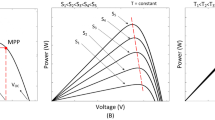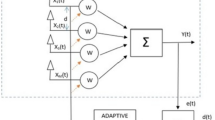Abstract
Adaptive beamformers are designed with the aim of detection of noise and intentional destructive interference and then removing them from the desired signal. This is done by placing high attenuation in the direction of the destructive signal in the radiation pattern of antenna arrays without attenuating the signal from a known direction. Minimum variance distortionless response and linearly constrained minimum variance are among such algorithms in mobile communications. A short explanation of the theory and weights formulae of these beamformers will be given. Two designs for weights calculations in Simulink with the added library of DSP-Builder tool from Altera will be presented. Quadrature Rectangular decomposition with Modified Gram-Schmidt algorithm is used instead of the direct matrix inversion. All calculations are done in single floating point mode for the required high accuracy. Modelsim has been used for hardware simulation and measuring the required clock cycles. The target FPGA is Aria10 from Altera which has floating point DSP blocks for high-performance computations. Hardware resources usage, power consumption, maximum clock frequency and update rate for different matrix sizes of these two beamformers are compared and discussed. The results are also compared with some other relevant reported works.











Similar content being viewed by others
References
Wang, S.-S., Tien, Y.-C., Hwang, Y.-T., Lin, J.-F., & Wu, G.-Z (2016). MVDR based adaptive beamformer design and its FPGA implementation for ultrasonic imaging. In IEEE Asia Pacific Conference on Circuits and Systems (APCCAS) (pp. 143–145).
Liang, Y.-W., Schober, R., & Gerstacker, W. (2009). Time-domain transmit beamforming for MIMO-OFDM systems with finite rate feedback. In IEEE Transactions on Communications, 57(9).
Blomberg, A. E. A., Austeng, A., Hansen, R. E., & Synnes, S. A. V. (2013). Improving sonar performance in shallow water using adaptive beamforming. IEEE Journal of Oceanic Engineering, 38(2), 297–307.
Lo, K. W. (2004). Adaptive array processing for wide-band active sonars. IEEE Journal of Oceanic Engineering, 29(3), 837–846.
Asl, B. M., & Mahloojifar, A. (2012). A low-complexity adaptive beamformer for ultrasound imaging using structured covariance matrix. In IEEE transactions on ultrasonics, ferroelectrics, and frequency control, 59(4).
Maskulainen, I., Luoto, P., Pirinen, P., Bennis, M., Horneman, K., & Latva-aho, M (2017). Performance evaluation of adaptive beamforming in 5G-V2X networks. In IEEE European Conference on Networks and Communications (EuCNC) (pp. 1–5).
Kikuchi, H., Yoshikawa, E., Ushio, T., Mizutani, F., & Wada, M. (2017). Application of adaptive digital beamforming to Osaka University phased array weather radar. In IEEE Transactions on Geoscience and Remote Sensing.
Chung, W.-C., Chen, C.-Y., Huang, C.-Y., Chang, C.-J., & Ren, F (2013). Ant colony-based radio resource allocation for LTE-A systems with MIMO and CoMP transmission. In IEEE/CIC International Conference on Communications in China (ICCC) (pp. 780–785).
Mu, P., Li, D., Yin, Q., & Guo, W. (2013). Robust MVDR beamforming based on covariance matrix reconstruction. Science China Information Sciences, 56(4), 1–12.
Van Veen, B. D., & Buckley, K. M. (1988). Beamforming: A versatile approach to spatial filtering. IEEE assp magazine, 5(2), 4–24.
Liu, W., & Weiss, S. (2010). Wideband beamforming: Concepts and techniques (17th ed.). Hoboken: Wiley.
Er, M., & Cantoni, A. (1983). Derivative constraints for broad-band element space antenna array processors. IEEE Transactions on Acoustics, Speech, and Signal Processing, 31(6), 1378–1393.
Van Trees, H. L. (2004). Detection, estimation, and modulation theory, optimum array processing. Hoboken: Wiley.
Liu, J. (2008). DCD algorithm: Architectures, FPGA implementations and applications. PHD Thesis, University of York, York, England.
Liu, C., Tang, C., Yuan, L., Xing, Z., & Zhang, Y. (2016). QR decomposition architecture using the iteration look-ahead modified Gram-Schmidt algorithm. IET Circuits, Devices and Systems, 10(5), 402–409.
Singh, C. K., Prasad, S. H., & Balsara, P. T. (2007). VLSI architecture for matrix inversion using modified gram-schmidt based QR decomposition. In Proceedings of the IEEE International Conference on VLSI Design (pp. 836–841).
Lin, K.-H., Lin, C.-H., Chang, R. C.-H., Huang, C.-L., & Chen, F.-C (2009). Iterative QR decomposition architecture using the modified Gram-Schmidt algorithm. In IEEE International Symposium on Circuits and Systems ISCAS 2009 (pp. 1409–1412).
Chang, R. C.-H., Lin, C.-H., Lin, K.-H., Huang, C.-L., & Chen, F.-C. (2010). Iterative QR decomposition architecture using the modified Gram-Schmidt algorithm for MIMO systems. IEEE Transactions on Circuits and Systems I: Regular Papers, 57(5), 1095–1102.
Liu, T.-H., Chiu, C.-N., Liu, P.-Y., & Chu, Y.-S. (2014). Block-wise QR-decomposition for the layered and hybrid alamouti STBC MIMO systems: Algorithms and hardware architectures. IEEE Transactions on Signal Processing, 62(18), 4737–4747.
Maltsev, A., Pestretsov, V., Maslennikov, R., & Khoryaev, A (2006). Triangular systolic array with reduced latency for QR-decomposition of complex matrices. In IEEE International Symposium and proceedings on Circuits and Systems ISCAS 2006 (p. 4).
Liu, J., Weaver, B., Zakharov, Y., & White, G (2007). An FPGA-based MVDR beamformer using dichotomous coordinate descent iterations. In 2007 IEEE International Conference on Communications (pp. 2551–2556).
Haykin, S. S. (2002). Adaptive Filter Theory (4th Ed.). Prentice-Hall, Inc.
Björck, Å. (1994). Numerics of gram-schmidt orthogonalization. Linear Algebra and its Applications, 197, 297–316.
Dick, C., Harris, F., Pajic, M., & Vuletic, D. (2007). Implementing a real-time beamformer on an FPGA platform. Xcell Journal, 86(60), 36–40.
Author information
Authors and Affiliations
Corresponding author
Rights and permissions
About this article
Cite this article
Amin-Nejad, S., Gashteroodkhani, T.A. & Basharkhah, K. A Comparison of MVDR and LCMV Beamformers’ Floating Point Implementations on FPGAs. Wireless Pers Commun 98, 1913–1929 (2018). https://doi.org/10.1007/s11277-017-4953-1
Published:
Issue Date:
DOI: https://doi.org/10.1007/s11277-017-4953-1




